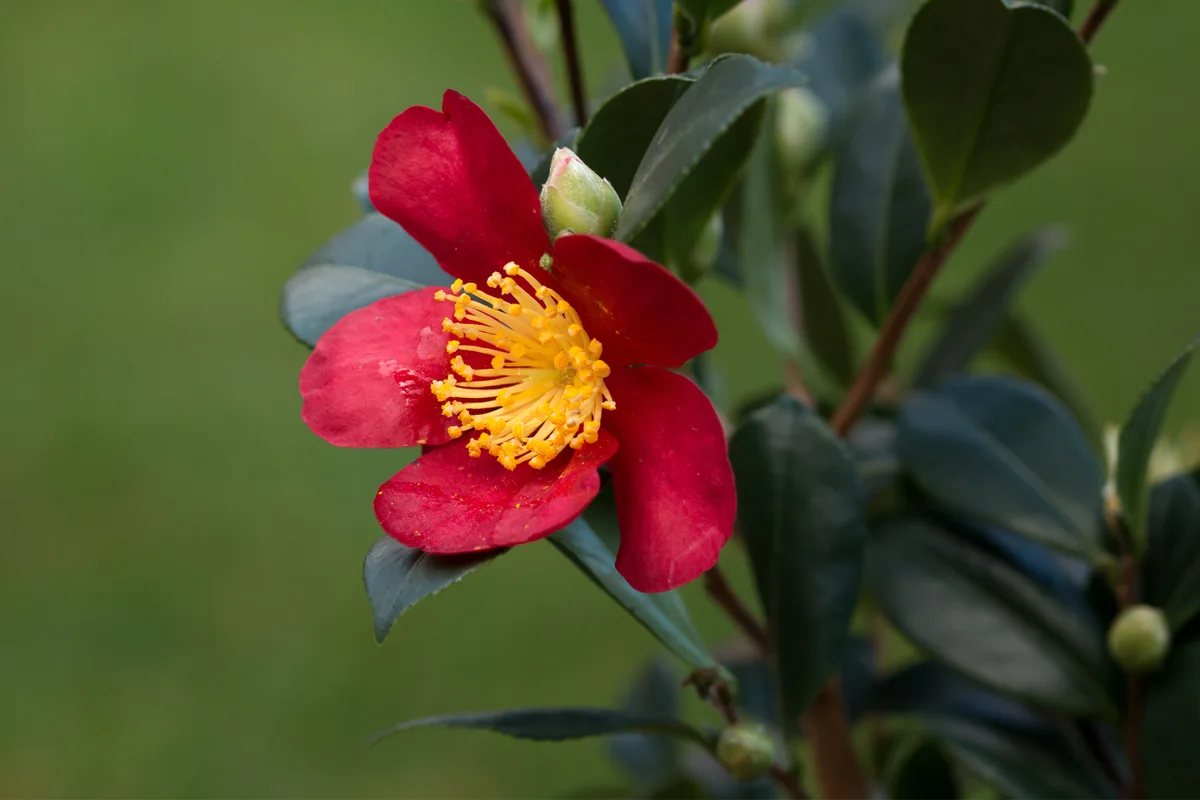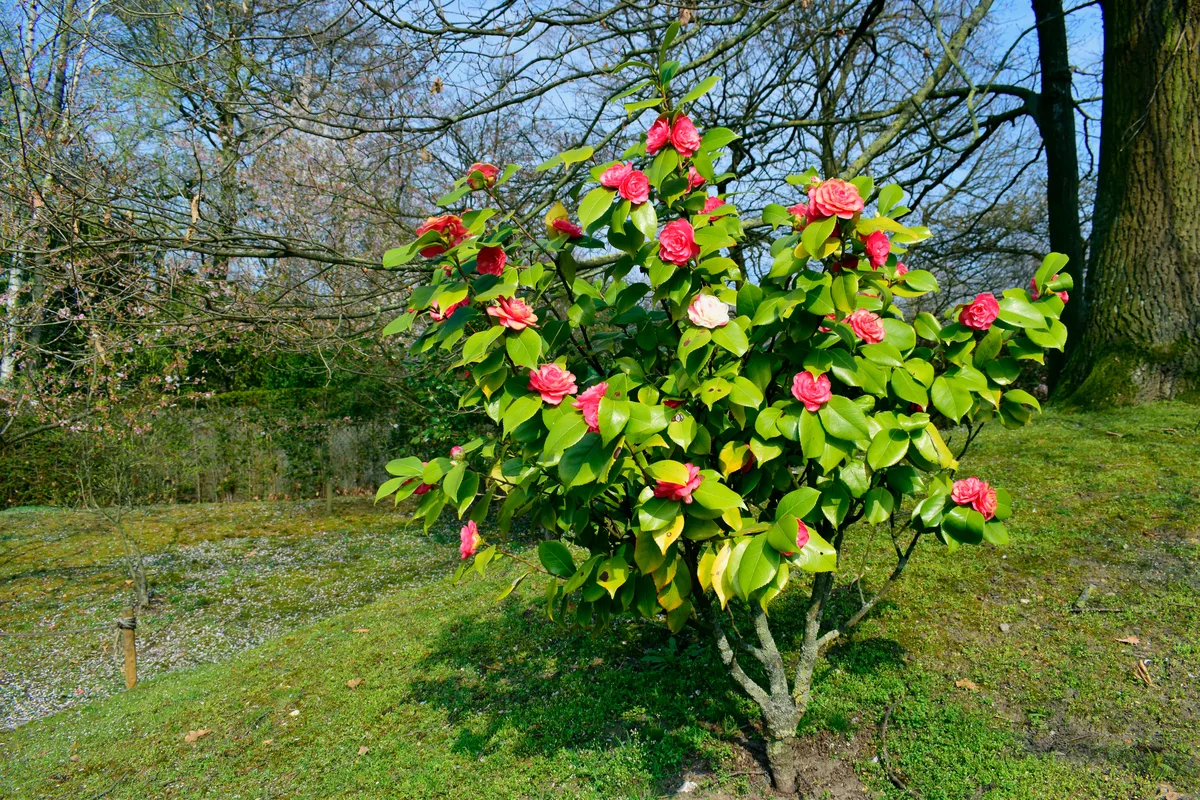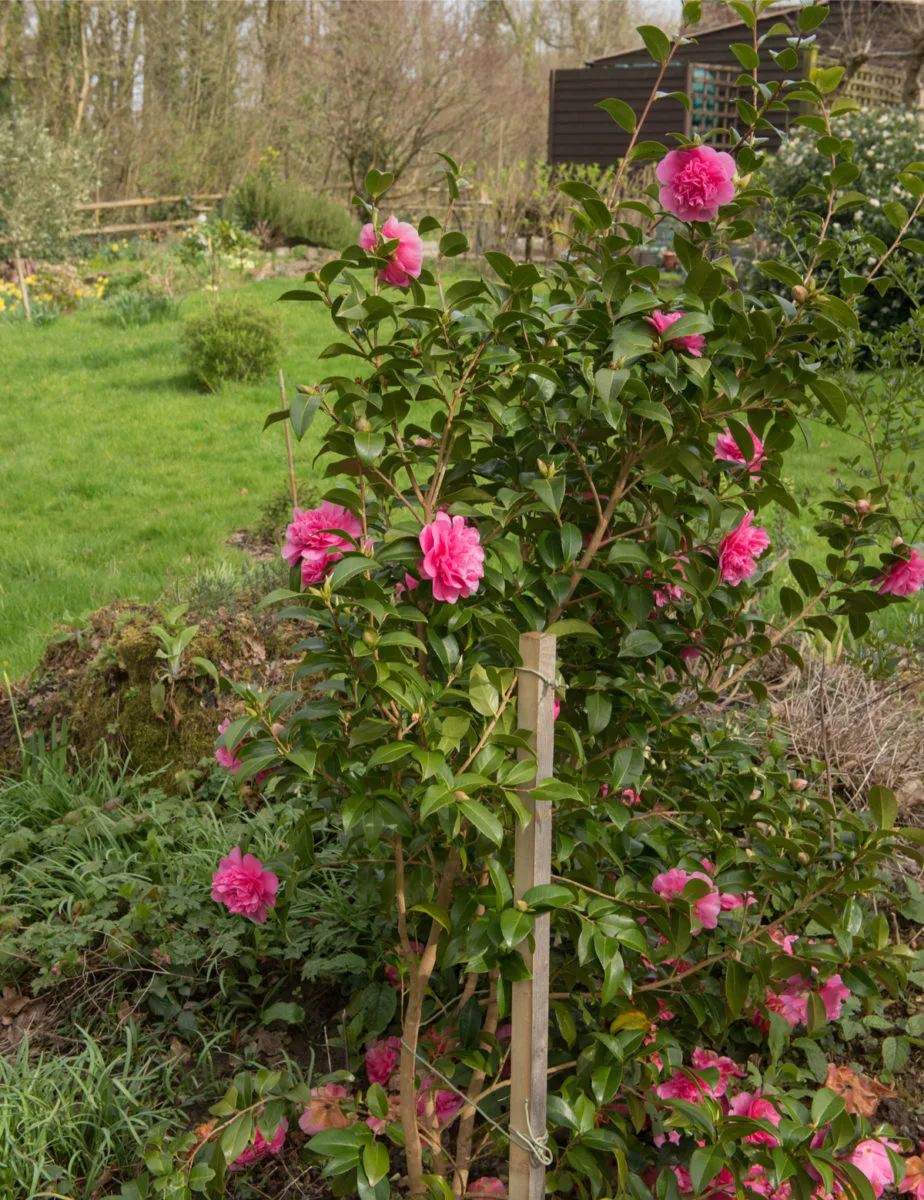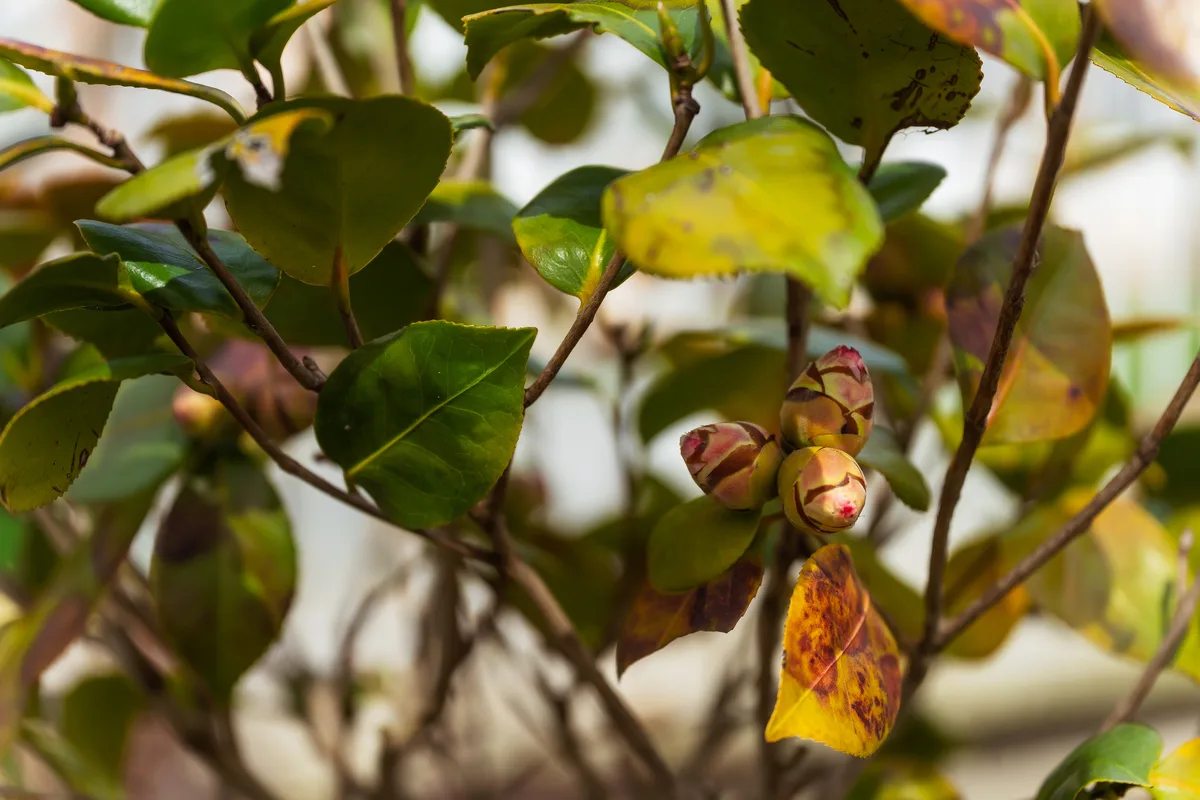
When I moved into my current home, I became the accidental step-parent of a majestic Camellia japonica bush.
The woman who was moving out estimated the camellia was about seven years old and she made me promise that I’d take good care of it.

Little did she know that I was plant-obsessed. Not only did I shower my love on the existing camellia, but I set out to expand my collection by sourcing more varieties that would do well in my neck of the woods.
Along the way, I’ve become a camellia know-it-all by researching how to get beautiful camellia blooms from all the trustworthy sources I could find – mainly university extensions and Master Gardener programs in my area, as well as the American Camellia Society.

If you, too, want to give camellias a go in your garden, or if you caught the camellia bug a long time ago and are just looking for a refresher, here is my advice on how to get abundant and beautiful camellia blooms.
Oh, and just so we’re all on the same page here, we’ll be talking about Camellia japonica and its southern sister Camellia sasanqua, the two types of camellias that are commonly grown by gardeners for their ornamental beauty.
What’s the difference between Camellia sasanqua and Camellia japonica?
Sasanqua camellias (Camellia sasanqua)
Let’s start with Camellia sasanqua because they are the first ones to bloom, usually in mid-fall to early winter. They range in size from a foot-tall compact plant to up to twelve feet tall.
The more compact varieties are perfect for placements in urban gardens, small front gardens and decorative containers. Both the leaves and the blooms typically stay smaller than those of its japonica counterpart.
Here are a few popular Camellia sasanqua cultivars to look for:

Camellia sasanqua ‘Yuletide’ – single red flowers that bloom in December;
Camellia sasanqua ‘Debutante’ – blush-pink blooms that resemble peonies;
Camellia sasanqua ‘Setsugekka’ – a semi-double white variety with frayed petals;
Camellia sasanqua ‘Pink-a-boo’ – fragrant pastel-pink blooms with golden stamens;
Camellia sasanqua ‘Kanjiro’ – a fuchsia-colored double blooms that are slightly fragrant.
Japanese camellias (Camellia japonica)
These camellias bloom in winter and early spring. They’re typically mid-sized to large shrubs, but they can also be shaped to resemble small trees. This type of camellia can grow up to twenty feet tall and ten feet wide, so keep that in mind when you choose its final location in your garden.
The blooms, which can reach six inches across, come in a variety of colors, ranging from red to pink, white and peachy. The flowers of the camellia japonica may be single, semi-double or double. Some varieties can bloom as early as December while others will open as late as April.
Here are a few popular Camellia japonica cultivars to look for:

Camellia japonica ‘Pink Perfection’ – an older cultivar that produces pale pink double blooms;
Camellia japonica ‘Mrs. Tingley’ – double blooms in salmon-pink hues;
Camellia japonica ‘Swan Lake’ – creamy white flowers with golden stamens;
Camellia japonica ‘Seafoam’ – an abundant bloomer that produces large white flowers;

Camellia japonica ‘Margaret Davis’ – stunning white blooms with pink frilly edges.
Camellia japonica ‘Professor Sargent’ – gorgeous deep-red double blooms;
Camellia japonica ‘Jury’s Yellow’ – large buttery-white double blooms;

There are even varieties of camellia hybrids that have scented blooms:
Camellia williamsii ‘Buttermint’ – creamy yellow semi-double blooms that smell like mint;
Camellia williamsii ‘Good Fragrance’ – pink single-bloom scented camellia with notes of honeysuckle;
Camellia lutchuensis ‘High Fragrance’ – pale-pink semi-double blooms whose fragrance resembles that of roses.
Now that you know what types of camellias are available for gardeners, here are some tips on how to get an abundance of beautiful camellia blooms that last for weeks.
1. Choose the right camellia for your climate and your garden.
In the United States, camellias have been bred and sold commercially since the 1810s. Even more surprisingly, the oldest documented camellia japonica tree (in Portugal) dates back to the 16th century. Having been around for so long, it’s no wonder that there are thousands of camellia cultivars on the market.
In the United States alone, the American Camellia Society (based in Georgia) has a database of over four thousand registered cultivars, dating back to the founding of the society in 1945.

I’m not mentioning this bit of trivia to overwhelm you, but to reassure you that there is certainly a camellia cultivar out there for your specific situation and climate.
When choosing the right camellia for your climate, the key aspect to pay attention to is cold hardiness.
Most camellias will do well in USDA zones 7-10, where winters don’t get very cold and temperatures generally stay above freezing. If you’re looking for hardier varieties, pay attention to the name of the cultivar you’re choosing. Names that hint at winter, will indicate cold hardiness (but again, nothing is one hundred percent guaranteed when it comes to plants).
A few examples of cold-hardy camellias include:

Camellia ‘Winter’s Star’
Camellia ‘Snow Flurry’
Camellia ‘Frost Princess’
Camellia ‘Ice Angels’
Camellia ‘Winter’s Snowman’
If it’s the blooms you’re after, and if you have the space, you could extend the blooming season by planting different varieties of camellia.
For fall and early winter blooms, you can choose a sasanqua cultivar. For late winter and early spring bloom, opt for a japonica cultivar. Keep in mind that fall and winter-blooming varieties require a bit more sun in order to have rich blooms, but spring-blooming varieties can handle some shade (more on this below).

My advice is to look for the right camellia for your (micro-)climate at your local brick-and-mortar plant nursery first. They’ll know what does well in your particular area and generally give more personalized advice than you’ll find at big-box retailers.
Another good source of personalized information is the agricultural extension of your nearest university or community college. And while you’re at it, do a quick online search for “camellia societies” or “camellia clubs” followed by your location.
2. Place your camellia in a spot with sufficient sunlight.
Once properly established, camellias are long-lived plants that will keep going strong for decades. So it’s worth it to consider carefully the most important aspects of the site you choose for them. Undoubtedly one of the most important factors, and one that’s very hard to change, is the amount of sunlight your plant will get.

A common misconception is that camellias should get as much sun as possible. Yes, it’s true that camellia plants should be planted in a sunny spot, as long as they get a bit of afternoon respite from the hot rays. Camellias will do best in a sheltered location that gets plenty of morning sun balanced by afternoon shade. This is especially important for young camellias that you’re just trying to get established. As the plant matures and grows, the canopy will act as an umbrella for the roots and your camellia will be able to take more sun.
Having plentiful sun is essential for bloom formation while getting some shade is important for overall plant health. Too much unfiltered sunlight can dry out the plant tissue over time and cause scorched leaves and bleached blooms which may shrivel up and fall before opening. On the other hand, too much shade can lead to stunted growth and poor blooming.

Some sasanqua camellia varieties are a little more sensitive to cold than their japonica counterparts and thus can handle more sun if you water them properly (always read the grower’s labels for personalized instructions).
As a general rule of thumb, the hotter the climate you’re gardening in, the more shade protection your camellia needs.
3. Amend the planting site before you transplant your camellia.
Thorough pre-planting preparation is the key to a good head start for any new plant that takes residence in your garden.
In most gardening zones, fall planting works better than trying to get a camellia established in any other season. Both summer heat and winter frost bring unnecessary stress to the newly planted bush, so if possible, wait until early- to mid-fall to get a new plant in the ground. However, if you have really short and cool falls and early winters, you can also plant your camellia in spring.

In their native habitat (in eastern Asia), camellias grow in rich, well-draining soil on slopes and often under pine trees. That means the soil that they’re anchored in is naturally acidic.
Ideally, we should replicate these conditions as much as possible in our own gardens, although breeders have been creating new cultivars that are a bit more flexible in their demands.
Before you plant your camellia, you can amend the planting site with organic matter such as organic compost, leaf mold or aged manure. If you can, try to improve your site pre-planting with organic materials that will slowly decompose and feed the soil. Work the organic matter into the soil about ten inches deep to improve its structure.
If your soil is too alkaline, clay-heavy or compacted, here’s a good guide on how you can make your soil more acidic (and what not to do), the old-fashioned way. Camellias do well in an area where the pH stays between 5.0 and 6.5. In general, if you’re growing azaleas, rhododendrons and berries successfully, you’ll have no problems growing camellias.
4. Help your camellia get established.
In addition to being planted in the right type of soil (which we’ve covered above), this advice covers so much more ground. So here are a few tips to make sure your young camellia gets properly established in the first couple of years in your garden.
First of all, do not bury your camellia’s roots too deeply. You should bury them enough to be fully covered, but not so deep as to start covering the stem. The deeper the planting hole, the longer it will take for your camellia to start showing signs of growth. If your site allows, plant your camellia slightly above the surrounding grade, and slope the soil up to cover the root ball.
Once you’ve planted your camellia, you can add a thin layer of mulch (bark, leaves or worm castings will work) over the planting area to help the soil retain its moisture and keep the temperature around the roots constant. However, try to keep the mulch from making direct contact with the stem.

Secondly, always make sure you leave enough space around your camellia. Even though it’s not a fast-growing plant, it’s an ever-growing plant with a really robust form. Camellias love being able to expand and don’t like to be smothered by other green buddies. So allow twenty to thirty inches around the crown of the plant.
Along the same lines, do not cram your camellia into a very small location, unless you’ve specifically bought a small variety meant for growing in a container, such as Camellia sasanqua ‘Mignonne’, Camellia sasanqua ‘Dream Angel’ and Camellia sasanqua ‘Paradise Petite’.

Some camellia varieties can also be grown in pots, but they will not get as many blooms.
Next, camellias should be sheltered from windy locations, as both cold and hot winds may interfere with plant growth and bloom production. Both winter winds and summer winds, if strong enough, will make the plant look sickly and scorched. Place your camellia next to a fence, a wall or another sturdy structure that can keep it sheltered.
5. Keep your camellias on a consistent watering schedule.
The thick glossy leaves of the camellia may trick you into believing that this plant doesn’t need too much water and that it can handle drought.
But if you want to get beautiful camellia blooms, you have to keep to a consistent watering schedule. Of course, as gardeners, we work with Mother Nature to keep our gardens lush and productive. And as in every good team, collaboration and complementing each other is crucial for success. But don’t just rely on Mother Nature to replenish the water in your garden.

In the first year, you should water your camellia regularly to help it get established. Once your camellia bush finds its feet, rainfall will be enough. But you should go back to watering at least a couple of times a week if you’re going through a dry spell.
Speaking of feet, camellias don’t like to have soggy feet, so make sure the site is draining properly before you give it more water. If you followed the soil amending advice that we mentioned above, you should be fine.
Of course, rainwater is slightly acidic, and your camellia will prefer it to tap water (which in some areas might be a bit too alkaline). If you have the space, consider setting up a rain barrel to collect rainwater for all your acid-loving garden plants.

Camellias set their buds during the previous summer, so keeping them well-watered, especially in July, is very important. Large fluctuations in moisture will also impact bloom, so try to avoid letting it dry out for too long if you’re experiencing a dry summer.
6. Prune your camellia lightly, if at all.
Due to its blooming period, very different from almost everything else in the garden, the usual pruning advice does not apply to camellias. The plant sets buds for the following season sometimes as early as mid-summer (the year before), so if you’re waiting too long to prune it, you may end up cutting off next year’s buds.
The best time to prune your camellia is right after the blooms are spent. However, if your plant blooms really early in the year, wait until the last expected frost date has passed before you prune.

Again, contrary to usual pruning advice, camellias only need a light pruning, just enough to contour and maintain their shape. You can cut back the lower branches to encourage vertical growth or trim the top growth to encourage a fuller-looking plant. If the branches are thick and packed in, you can also thin them down in order to improve airflow. Camellia sasanqua varieties grow faster in warmer climates, so you may need to prune them more frequently.
However, always remember to always keep your pruning on the light side with camellia bushes.
7. Don’t fertilize too much or too often.
One of the things I like about camellias is that they are not particularly heavy feeders. In this sense, it’s the perfect plant for the overwhelmed gardener. (And believe me, I count myself as one, especially in summer when so many other gardening jobs compete for my attention.)
This may come as a surprise to some of our readers who may be used to feeding blooming plants with a bit too much of a heavy hand.
If you’ve planted your camellia in rich soil amended with the much-needed nutrients we’ve mentioned above, you don’t need to feed it too often. On the other hand, if your camellia is growing in a container or in sandy soil, it may benefit from an extra dose of nutrients.

If you really want to fertilize your camellia, you should choose a slow-release organic fertilizer designed for acid-loving plants. To save money and save on the hassle, you can buy the same type of fertilizer for your camellias, rhododendrons and azaleas.
The trick for getting beautiful camellia blooms is to use a fertilizer that has a lower nitrogen content. How do you know if you’re buying low-nitrogen feed? Easy: you’ll see on the label that the first number of the sequence is lower than the other two numbers. For example, a 4-8-8 fertilizer is low in nitrogen and a good choice for a blooming plant. Nitrogen, while good for a plant that’s still getting established, promotes foliar growth, often at the expense of blooms.

The best time to feed your camellia is once the blooms have died and the plant is starting to accumulate energy for next year’s flowers. For most gardeners, that would be in March, April and early May, depending on your climate. You can give your camellia a second round of feeding in late summer.
Do not fertilize the plant later in the season, in order to avoid encouraging new growth that will be more vulnerable to low temperatures.
8. If possible, shelter your camellia plant on really cold days.
This is a tricky one, because the last thing you want to do in the dead of winter is to go outdoors and tuck your plant in every night. But it’s worth knowing that the buds of camellia japonica cannot handle temperatures that go much below freezing. The buds are not tolerant of extreme temperatures, so they will just shrivel, turn brown and fall if exposed to prolonged periods of frost.

If you’re paying close attention to the weather and to your plants as well, you should be able to cut a few buds and bring them indoors to enjoy as a tabletop arrangement.
Another option is trying to cover the plant with horticultural fleece to shelter it from the cold. However, if temperatures stay below freezing for too long, even this solution will not help insulate your camellia long-term. Ideally, you want the protective cover to hover above the blooms, rather than rest on them. So even a fleece setup may backfire, as it’s tricky to set up a tent-like structure to avoid the buds touching the fleece.

If you decide to cover your plants, just remember to remove the cover during the day, if the sun is shining. Keeping the plants covered long-term leads to poor air circulation and encourages the development of mildew and other fungal diseases.
Now you know all of my secrets for beautiful camellia blooms. My camellia plants, with their deep green glossy leaves and pink blooms, are such a sight for sore eyes on gloomy winter days. I think that if you choose to grow camellias, you’ll be thoroughly rewarded every winter.

